
OLN.E | The Daring Dozen
Why are the manned moon landings all called Apollo? In 1960, Dr. Abe Silverstein was the Director of Space Flight Programs for NASA. He had been reading about mythology, and chose Apollo for the next series of space missions because, “Apollo riding his chariot across the sun was appropriate to the grand scale of the proposed program.”
Even though no one has landed on the Moon more than once, three different astronauts have traveled to the Moon more than once. Jim Lovell orbited the Moon on Apollo 8 and flew around the Moon on the aborted Apollo 13 mission. John Young and Gene Cernan were both on Apollo 10 which orbited the Moon; Young then walked on the moon on Apollo 16, and Cernan walked on the Moon during Apollo 17.
Apollo 11 – July 1969
The first mission to put men on the moon, Apollo 11, landed in July of 1969. Michael Collins, as command module pilot, stayed on board, while Neil Armstrong and Buzz Aldrin walked on the moon.
On their mission, they collected rocks, planted the US flag, and deployed a seismograph and an experiment called the Lunar Ranging Retroreflector – a .reflective device that measures the distance between the Earth and the Moon using lasers from Earth — which is still in use today.
For details about the first two men to walk on another planet, click on their names below
Neil Alden Armstrong
- Neil was first assigned as an astronaut in 1962.

- He flew on the Gemini 8 mission in 1966, where he performed the first successful space docking procedure.
- He was selected to be the first man to walk on the moon because he was the commander of the mission, didn’t have a big ego, and the door of the lunar lander was on his side.
Edwin "Buzz" Aldrin
- The nickname “Buzz” came from his sister, who had trouble pronouncing the word “brother,” referring to him as “buzzer.”

- He legally changed his name to Buzz in 1980.
- His mother’s maiden name is Moon.
- Buzz took a home Communion kit with him, and took Communion on the lunar surface, but did not broadcast the fact.
- His first words on the moon were, “Beautiful view, magnificent desolation.”
Apollo 12 – November 1969
Even though it was raining at Cape Kennedy when Apollo 12 was scheduled to launch, NASA didn’t postpone the mission. The Saturn V rocket carrying Charles Conrad, Richard Gordon, and Alan Bean was struck by lightning almost immediately. The jolts knocked out the guidance system and power for a time, but thanks to quick thinking by Mission Control and Alan Bean, the systems were recovered.
While on the moon, Conrad and Bean installed the first nuclear power generator station on the Moon to provide the power source for scientific instruments and systems.
To find out more about the next two men to walk on the moon, click their names below.
Charles "Pete" Conrad

Before the Apollo missions, Pete Conrad set records as part of the Gemini crew. On Gemini 5, he and crewmate Gordon Cooper remained in space for a record-breaking five days in the phone-booth-sized ship. On Gemini 11, he and crewmate Richard Gordon spent three days in Earth orbit, achieving a new altitude record, 850 miles, high enough to clearly see the curvature of the planet.
- Conrad didn’t think anyone would pay attention to his first words, so he said, “Whoopee! Man, that may have been a small one for Neil, but that’s a long one for me.”
- He also flew on the Skylab 2 mission as commander with the first crew to board the space station.
Alan L. Bean
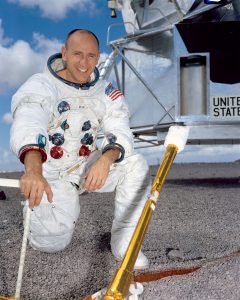
Alan Bean was the first astronaut to dive in the Neutral Buoyancy Simulator and was a champion of the process for astronaut training.
- He is the only artist to have visited another world. In 1981, Bean decided to resign from NASA to pursue full-time painting.
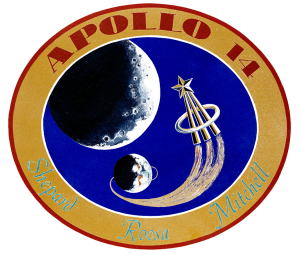
Apollo 14 – February 1971
While Alan B. Shepard, Jr. and Edgar D. Mitchell were on the lunar surface, Stuart A. Roosa was piloting the command module.
Down on the surface, Shepard and Mitchell deployed the Apollo Lunar Scientific Experiment Package (ALSEP), designed to determine lunar characteristics and provide new insights into the geology and geophysics of the Earth.
During their second moonwalk, they tried to reach the edge of a crater named Cone Crater, but they had no obvious landmarks amid the rolling, repetitive terrain, so they weren’t able to find it. When they analysed the data later, they realized that the duo had come within just 26 meters (65 feet) of the crater’s rim.
For more details about Shepard and Mitchell, click their names below.
Alan Shepard
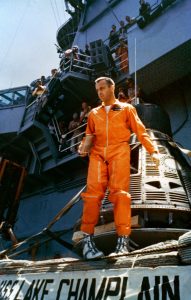
Alan Shepard was the first American launched into space aboard the Freedom 7 spacecraft on May 5, 1961. His suborbital flight reached an altitude of 116 miles.
- He made the most accurate lunar module landing ever.
- He was the oldest person to walk on the moon, at 47 years and 80 days.
- He knocked a couple of golf balls with a six-iron attached to his sample-collecting tool. With one arm (due to the space suit), he managed to drive further than professional golfers on Earth could ever hope to, thanks to the moon’s lower gravity.
Edgar G. Mitchell

During the Apollo 13 crisis, Mitchell was a part of the Apollo 13 Mission Operations Team.
- He worked in an Apollo simulator to help bring the crew back.
- One issue he worked on was how to “fly” (meaning control the attitude of) the Lunar Module with an inert Apollo Command/Service Module attached to it. Usually it was the other way around, but the Service Module was damaged during that mission.

Apollo 15 – July 1971
Before this mission, astronauts got around by walking, but since this was the first mission to land near mountains, NASA sent the first moon buggy, the Lunar Roving Vehicle. David Scott and James Irwin got to navigate the vehicle; Alfred Worden, the command module pilot, never got to go joyriding.
During three moonwalks (or moon drives), Scott and Irwin deployed several science experiments and collected 77 kg (170 lb) of lunar rock samples, and made one of the most important discoveries of the Apollo era, the Genesis Rock. They thought that this rock might be a part of the moon’s primordial crust, but later determined that it was only about 4 billion years old–not as old as the moon itself.
To learn more about the first people to ride on the moon as well as walk on it, click the names below.
David Randolph Scott
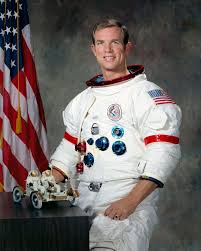
David Scott was the first automobile driver on the moon, of the Lunar Roving Vehicle.
- In front of the television camera, he dropped a hammer and a feather simultaneously to demonstrate Galileo’s theory that objects in a vacuum will drop at the same rate.
James B. Irwin

James Irwin was the first automobile passenger on the Moon (Scott drove the Lunar Roving Vehicle).
- While in space, he developed a heart condition. Ironically, this was the best place this could have happened.
- He was being continuously monitored.
- He was getting 100% oxygen.
- He was in zero g, which meant that there was minimal stress on his heart.
- Interestingly, the condition disappeared by the time he returned to Earth, and did not reoccur.

Apollo 16 – April 1972
When John W. Young, Thomas K. Mattingly, and Charles M. Duke, Jr. reached lunar orbit, the mission almost had to be aborted because of a problem with Command/Service Module’s main engine. When they did land, it was the first mission to do so in the lunar highlands.
Despite the rough beginning, the crew placed the largest payload in lunar orbit (76,109 lb or 34,595 kg), as well as the first cosmic ray detector deployed on the lunar surface, and the first lunar observatory with the far UV camera.
Want to know more about these men? Click on the links below.
John Watts Young
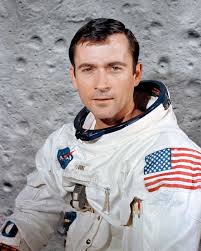
John Young’s first space flight was in 1965 aboard Gemini 3 with Gus Grissom, where he smuggled a corned beef sandwich onto the flight. NASA was not happy.
- He was also commander of the first space shuttle flight in 1981.
- He is the longest serving astronaut in NASA history (as of 2019). He retired in 2004 after 42 years of service.
Charles M. Duke Jr.

Charles Duke is the youngest person to walk on the moon, at 36 years and 201 days old.
- He was CAPCOM (Capsule Communicator, a role on the ground filled by a another astronaut, as someone who can best understand the situation in the spacecraft) for Apollo 11.
- He became very well known for his Texas accent.
- His first words to the Apollo 11 crew when they reached the surface of the Moon (after a complicated descent) were somewhat flustered: “Roger, Twank…Tranquility, we copy you on the ground. You got a bunch of guys about to turn blue here. We’re breathing again. Thanks a lot!”
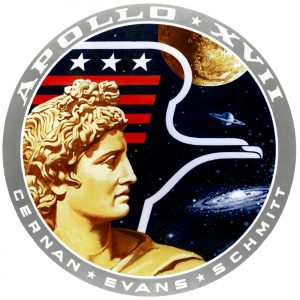
Apollo 17 – December 1972
The last Apollo mission still had a first of its own–it was the first night time liftoff of a Saturn V rocket. Jack Schmitt and Gene Cernan also set a record for longest time spent on the lunar surface–three days–while command module pilot Ronald E. Evans stayed in space.
To learn more about the last two men on the moon, click the names below.
Harrison "Jack" Schmitt
- J
 ack Schmitt was the first scientist in outer space–all previous astronauts had trained as test pilots first. He got his Bachelor’s degree in geology from Caltech in 1957
ack Schmitt was the first scientist in outer space–all previous astronauts had trained as test pilots first. He got his Bachelor’s degree in geology from Caltech in 1957
and his Ph.D from Harvard in 1964. - He was originally assigned to Apollo 18, but all further flights were cancelled in 1970“
- The community of lunar geologists pressured NASA to reassign Schmitt to the final mission, Apollo 17“
- Schmitt claims he took the photograph of the Earth known as The Blue Marble, possibly one of the most widely distributed photographic images in existence. NASA officially credits the image to the entire Apollo 17 crew.“
Eugene E. Cernan
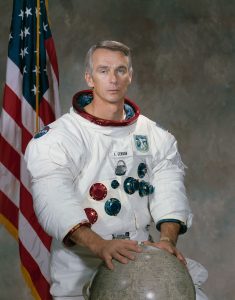
Cernan was the last person to walk on the moon, finishing his moonwalk early in the morning on December 14, 1972.
- Before he left the Moon, Cernan scratched the initials of his daughter Tracy into a rock on its surface.
- In September of 2011, Cernan testified before Congress on the future of the space program. ”The space program has never been an entitlement, it’s an investment in the future – an investment in technology, jobs, international respect and geo-political leadership, and perhaps most importantly in the inspiration and education of our youth.“
Curriculum Reference Links
- Earth and Space / Sustainability / 8: Students should be able to examine some of the current hazards and benefits of space exploration and discuss the future role and implications of space exploration in society.






